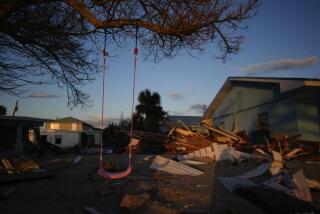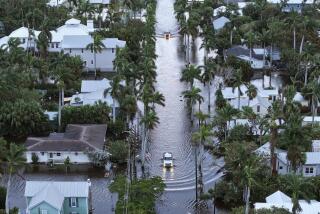Troubles Soak St. Louis as Record Crests Near
ST. LOUIS — Record crests for the Missouri and Mississippi rivers were one day away this morning from the most densely populated region to feel the waters’ wrath. And already on Saturday this city and its suburbs were caught in the throes of a true urban flood.
Bridge closures snarled traffic, a levee protecting a sewage treatment plant fell, 18 people were rescued by boat and helicopter from a submerged industrial area where a fire also broke out, and evacuees waited to hear the fate of 48 propane tanks precariously close to floating into each other and possibly exploding.
As some officials debated whether the flood wall in St. Louis is high enough, others prepared evacuation plans for the city’s 16-mile Mississippi flank, where toxic chemicals could be unleashed if a heavy manufacturing district there is affected.
Meanwhile, the rains returned. Although they did not approach the scale of the deluges that wrought the floods, evening thunderstorms rumbled ominously over the area Saturday and three tornadoes were reported.
But the full onslaught is yet to come. The crests themselves are due to arrive Monday, and predictions of the river height have risen ever higher. The latest revision for the Mississippi was up three-tenths of a foot, to 49.3, and for the Missouri it was up 1.5 feet, to 38.5.
Across the Missouri, in St. Charles County, sandbag requests increased drastically as housing subdivisions and a McDonnell Douglas Corp. electronics-and-missile factory escalated their preparations for the crest. The flooding there already reached the richest of the rich: Beer tycoon August Busch III lost his hunting lodge.
The day’s highest drama came at Gumbo Flats, a mixed farming, light-industrial and commercial portion of suburban Chesterfield, west of St. Louis. The Monarch levee broke there Friday night; by morning, the Missouri was in full possession of 4,000 acres.
Eighteen people who disregarded a warning to move out the day before as the levee weakened were rescued.
The first to be rescued was John J. Uihlein, 56, who was spotted by a Missouri Highway Patrol helicopter pilot. Uihlein was trying to carry two boxes while walking through a flooded intersection Saturday morning. His cargo nearly cost him his life.
The swift current trapped Uihlein against a road sign. The copter pilot approached twice, according to the incident report, but Uihlein refused to drop his load.
The pilot flew away, returning with Chesterfield police officer Jeffrey Chellis, who yelled an order to let the boxes go. Uihlein held tight.
Finally, Chellis removed his seat belt, stepped out onto the helicopter skid and shouted: “You are going to die.” Only then did Uihlein release one box, then the other. Chellis pulled him to safety.
Reached by telephone later, Uihlein preferred to keep secret the contents of the boxes. “Things related to my business,” was all he would say. Asked what that business was, he refused to comment.
A few hours later, an airborne TV news crew noticed another pedestrian. This man, later identified as Chris Ohler, was wearing a yellow flotation vest as he waded through water up to his armpits.
A St. Louis County police pilot hovered over a rooftop long enough for an officer and a police lieutenant to get out and hook a mesh net to the bottom of the copter. The officer, Mike Hutcherson, got in.
The craft then maneuvered between trees and power lines, within 25 feet of the rushing water. Hutcherson scooped Ohler up. Ohler told him he had been trapped at a tavern where he worked and thought no one would know he was there if he stayed inside.
The other 16 who were rescued emerged by midday, as U.S. Coast Guard helicopters and Chesterfield Fire Department boats shuttled the stranded from rooftops and decks to dry land.
Contractor Mike Harris, for one, had ignored his wife’s entreaties to come out after the levee broke. He wanted to help friends, a married couple, save their Smokehouse Market, a gourmet grocery store. They declined an offer of a ride in a city dump truck that took the staff of a neighboring pet store away.
After laboring all night, Harris caught a few hours of sleep on a comforter thrown over a pile of sandbags. When he awoke about 5:30 a.m., the water was near. It broke through all their fortifications. As the basement filled and Harris ran upstairs, he could feel the first-story wooden floor creak from the pressure below. The wine cellar, an attached structure outside, tipped over.
He and his friends retreated to a second-floor apartment, where they talked about golf, took showers and napped until a helicopter arrived.
By early afternoon, an aerial tour revealed a sobering inventory. At the Spirit of St. Louis Airport, only the tails and wings of the few small planes that did not evacuate were visible. Warehouses were flooded up to their eaves.
A fire broke out on the roof of the Qual Tech Inc. furniture refinishing company. It had nowhere else to go, given that the rest of the building was submerged. Still, it took firefighters four hours to put out the blaze. Their boats and portable pumps were no match for the treacherous currents.
An oily film coated the floodwaters. “We don’t have any idea what chemicals are in the water now,” said Chesterfield Fire Department Inspector Roger Morris. “And it isn’t over yet.”
Six of the 30 bridges in the St. Louis area were closed due to high water, overloading the others. Worries about potential gridlock on Interstate 70 led officials to cancel two planned flood-relief benefit concerts at the Riverport Amphitheater, where Bob Dylan, John Mellencamp, Kenny Rogers and others had been slated to perform.
The massive Riverport levee was still safe, authorities stressed, as was the nearby Earth City levee. The two are keeping water from office and hotel complexes worth hundreds of millions of dollars.
They are the last two battlements left unbreached on the Missouri between Kansas City and St. Louis. The Chesterfield levee gave way on Saturday afternoon. Behind it, 10 of the 14 holding tanks at a sewage treatment plant were taking on floodwater. The plant was shut down and sewage diverted to other treatment facilities.
Fear of a possible fireball prompted authorities to keep more than 1,000 residents of the city’s south side away from their homes for a second straight day. Forty-eight propane tanks at a Phillips Petroleum storage facility on the banks of the Mississippi were knocked from their moorings by the force of the floodwater, resulting in some minor gas leaks.
Half a mile away, many of the evacuated residents tried to talk their way past police lines. Only in the most severe cases--one man needed heart medication--were people escorted into the 40-block area.
Dennis Gross, a house painter, considered his case exceptional, but police would not let him rescue his pets. He had found his neighborhood cordoned off when he returned from a Cardinals baseball game the night before.
“I’ve got a Rottweiler, a parrot and four cats,” he said. “Unless I get in there, Sugar Bear is going to finish off those cats. They’ve probably already gotten the bird.”
Repairs to a weakened section of the St. Louis flood wall were completed Saturday and the U.S. Army Corps of Engineers expressed confidence that the wall would meet the Mississippi’s test. It is designed to hold a river stage of 52 feet at bay from an industrial zone below the bluff where most of the city sits.
Politicians, however, wondered aloud whether the city needs to take more drastic action in light of the surprises the surges have continued to dish out.
Rep. James M. Talent (R-Mo.) suggested that the Corps of Engineers blast holes in upstream levees at wildlife preserves to relieve some of the pressure on crest day. And Rep. Richard A. Gephardt (D-Mo.) told KSDK-TV in St. Louis: “I think we are at a point where we’ve got to start expecting the worst and hoping for the best. St. Louis could expect crests of 50 to 51 feet.” He added, though, that “we don’t think it will go over the flood walls.”
Times researcher Edith Stanley in St. Louis contributed to this story.
More to Read
Sign up for Essential California
The most important California stories and recommendations in your inbox every morning.
You may occasionally receive promotional content from the Los Angeles Times.










